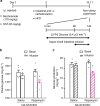Inhibition of upper small intestinal mTOR lowers plasma glucose levels by inhibiting glucose production
- PMID: 30755615
- PMCID: PMC6372624
- DOI: 10.1038/s41467-019-08582-7
Inhibition of upper small intestinal mTOR lowers plasma glucose levels by inhibiting glucose production
Abstract
Glucose homeostasis is partly controlled by the energy sensor mechanistic target of rapamycin (mTOR) in the muscle and liver. However, whether mTOR in the small intestine affects glucose homeostasis in vivo remains unknown. Here, we first report that delivery of rapamycin or an adenovirus encoding the dominant negative acting mTOR-mutated protein into the upper small intestine is sufficient to inhibit small intestinal mTOR signaling and lower glucose production in rodents with high fat diet-induced insulin resistance. Second, we found that molecular activation of small intestinal mTOR blunts the glucose-lowering effect of the oral anti-diabetic agent metformin, while inhibiting small intestinal mTOR alone lowers plasma glucose levels by inhibiting glucose production in rodents with diabetes as well. Thus, these findings illustrate that inhibiting upper small intestinal mTOR is sufficient and necessary to lower glucose production and enhance glucose homeostasis, and thereby unveil a previously unappreciated glucose-lowering effect of small intestinal mTOR.
Conflict of interest statement
The authors declare no competing interests.
Figures





Similar articles
-
mTOR partly mediates insulin resistance by phosphorylation of insulin receptor substrate-1 on serine(307) residues after burn.Burns. 2011 Feb;37(1):86-93. doi: 10.1016/j.burns.2010.04.005. Epub 2010 Jul 1. Burns. 2011. PMID: 20594757
-
Metformin Alters Upper Small Intestinal Microbiota that Impact a Glucose-SGLT1-Sensing Glucoregulatory Pathway.Cell Metab. 2018 Jan 9;27(1):101-117.e5. doi: 10.1016/j.cmet.2017.09.019. Epub 2017 Oct 19. Cell Metab. 2018. PMID: 29056513
-
Intestinal mTOR regulates GLP-1 production in mouse L cells.Diabetologia. 2015 Aug;58(8):1887-97. doi: 10.1007/s00125-015-3632-6. Epub 2015 Jun 3. Diabetologia. 2015. PMID: 26037201
-
Dissecting mammalian target of rapamycin to promote longevity.Rejuvenation Res. 2012 Jun;15(3):334-7. doi: 10.1089/rej.2012.1347. Rejuvenation Res. 2012. PMID: 22758368 Review.
-
mTOR Inhibitor Therapy and Metabolic Consequences: Where Do We Stand?Oxid Med Cell Longev. 2018 Jun 24;2018:2640342. doi: 10.1155/2018/2640342. eCollection 2018. Oxid Med Cell Longev. 2018. PMID: 30034573 Free PMC article. Review.
Cited by
-
Arf1 promotes porcine intestinal epithelial cell proliferation via the mTORC1 signaling pathway.In Vitro Cell Dev Biol Anim. 2024 Oct;60(9):1009-1020. doi: 10.1007/s11626-024-00942-y. Epub 2024 Aug 2. In Vitro Cell Dev Biol Anim. 2024. PMID: 39093368
-
Neuroimmune interactions: The bridge between inflammatory bowel disease and the gut microbiota.Clin Transl Med. 2025 May;15(5):e70329. doi: 10.1002/ctm2.70329. Clin Transl Med. 2025. PMID: 40400119 Free PMC article. Review.
-
Targeting colonic macrophages improves glycemic control in high-fat diet-induced obesity.Commun Biol. 2022 Apr 19;5(1):370. doi: 10.1038/s42003-022-03305-z. Commun Biol. 2022. PMID: 35440795 Free PMC article.
-
Metabolic regulation by the intestinal metformin-AMPK axis.Nat Commun. 2022 May 23;13(1):2851. doi: 10.1038/s41467-022-30477-3. Nat Commun. 2022. PMID: 35606343 Free PMC article.
-
An update on mode of action of metformin in modulation of meta-inflammation and inflammaging.Pharmacol Rep. 2022 Apr;74(2):310-322. doi: 10.1007/s43440-021-00334-z. Epub 2022 Jan 24. Pharmacol Rep. 2022. PMID: 35067907 Review.
References
Publication types
MeSH terms
Substances
LinkOut - more resources
Full Text Sources
Medical
Miscellaneous

